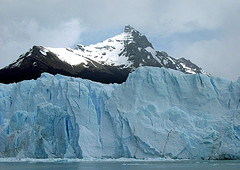
The thin sliver of land that is Chile is becoming even smaller. World news reports have made it well known that glaciers at both ice caps are melting, but new research by scientists from Chile’s Center of Scientific Studies (CECS) and NASA found that the Southern Patagonia Ice Field in the lower Andes Mountains is receding faster than any other ice field in the world.
Located at the southern tip of Chile, the Southern Patagonia Ice Field is the third largest continental ice concentration other than Greenland and Antarctica. Glaciers account for 75 percent of the world’s fresh water, but climate change has melted the glaciers resulting in a loss of fresh water and rising ocean levels. From 1995 to 2000, Patagonian glaciers were responsible for nine percent of the global glacier contribution to sea levels, receding an average of 57 meters per year. New findings suggest these figures could only grow.
Until recently, scientists had not been too concerned about the Southern Patagonia Ice Field due to flawed predictions and data. Previous hypotheses were that glacial loss only occurred from lower areas, and that snowfall in the upper sections helped maintain a total volume balance. Other studies stated that glaciers Trinidad and Pio XI - the largest in the southern hemisphere outside Antarctica — had advanced rather than receded, and that other famous glaciers in southern Argentina had remained unchanged. But new scientific studies have just concluded that ice in the upper altitudes is thinning as well, which leads experts to believe Patagonia’s glacier loss is much greater than previously calculated.
Most of Patagonia’s 3,500 glaciers are protected in national parks in Chile and Argentina, but stopping climate change from taking its toll on the giant ice fields will not be possible if no action is taken. Chile’s failure to establish an adequate renewable energy plan has kept the doors open for polluting coal- and diesel-burning factories, and the country’s CO2 levels are predicted to quadruple in the next twenty years if no action is taken. Chile is going to have to act fast if it wants to keep its icy tip like its name — chilly.

